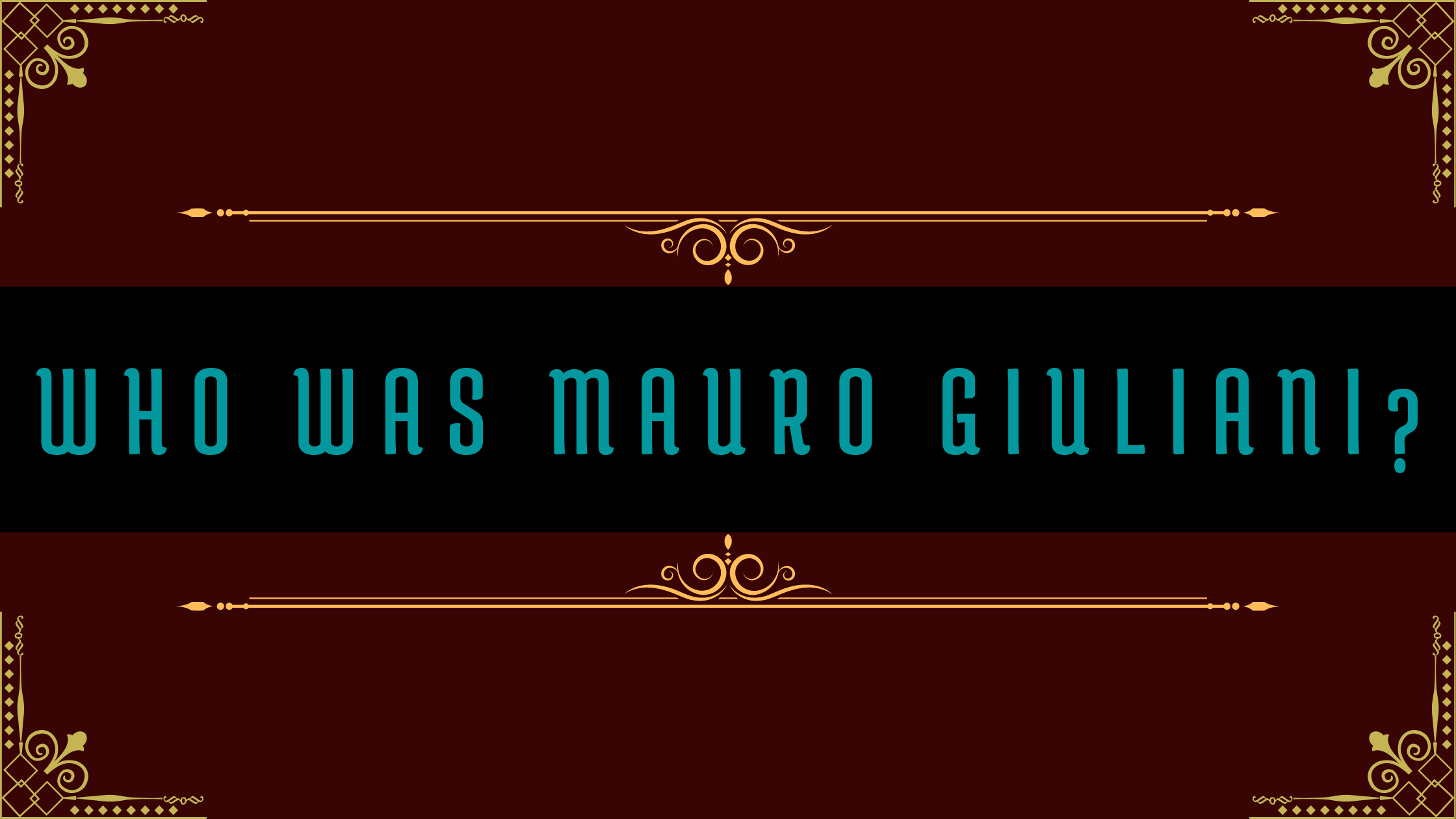Mauro Giuseppe Sergio Pantaleo Giuliani (for some reason shortened to Mauro Giuliani on every place where you will hear and read about stuff related to him) is one of the most know composers for classical guitar, mainly studied in Conservatory music school for his studies and didactic pieces, but also appreciated for concerts for his rich and beautiful more advanced compositions.
In this post we’ll talk about his life, his main works and where to find music sheets for his music without spending anything.
Life and Biography Section
On July 27, 1781, Mauro Giuliani was born in Bisceglie, Bari Province: he and his family then moved to Barletta, where he soon started taking lessons and learning the counterpoint, the cello, and also took French guitar lessons.
He married Maria Giuseppe del Monaco, and the two of them had a son that they named Michele in 1801. He then began his concert career as a classical guitarist, playing in a number of Italian and also foreign locations before moving to the city of Vienna in 1806, where he will stay up to 1819. In contrast to the Italian music, which was mostly related and heavily inspired to melodrama, he discovered the appropriate cultural environment and connections in the Austrian capital to be able to devote himself to instrumental music and composing pieces.
Giuliani quickly gained recognition as one of the most skilled living guitarists, earning him the nickname of “The Paganini of the guitar” and also easily earning invitations to play at the most prestigious and famous classical music schools. He also had success as a composer in Vienna, with the majority of his compositions appearing with in the operas and pieces of Artaria, Diabelli, Bermann, Haslinger, Hofmeister, Mollo, Cappi, and Riedl.
Here he also had an affair with Fräulein Willmuth in 1807:she was the mother of Maria, one of Giuliani’s daughters. He was also invited as a guest to Joseph Haydn’s 75th birthday party on March 27, 1808, together with other respected musicians such as Ludwig van Beethoven, Antonio Salieri, and many other well-known musicians.
In this same year, his fairly majestic Grand Concerto for Guitar and Orchestra (Op. 30) debuted and also marked the debut of the classical guitar (that was still considered by some as a simple instrument to support singers) in a large chamber setting together with other instruments traditionally associated with theathers and opera (such as piano, horns, brass instruments and other) and also received huge acclaim from both the reviewers and the several audiences.
Giuliani performed as the cello during the premiere of Beethoven’s Seventh Symphony on December 8, 1813, under the conductor’s direction; the next year, Maria Luisa of Austria named him a “honorary chamber virtuoso.”
In 1815 he also organized a series of chamber concerts at the Schönnbrun Botanical Garden location with the assistance of the pianist Johann Nepomuk Hummel (later Ignaz Moscheles), the violinist Josef Mayseder, and the cellist Joseph Merk, a performance that was definitely well received by the demanding Viennese musical circles, used to hear the biggest composers and the most majestic operas as the city was one of the cultural capitals of Europe in this specific period.
This wasn’t all, though: he also performed in that same year during the big Congress of Vienna celebrations, where he played Beethoven’s Overture from Op. 115 in a trio with Moscheles and the Mayseder between April and May of 1818.
On August 18, 1818, he performed the Grand pot-pourri (op. 67) in duo with Leonard Schultz. Giuliani was forced to return to Italy in 1819 as a result of both economic hardship and a decline in demand for the guitar in favor of the piano: he first arrived in Venice city before traveling to Trieste, Padua, and finally Rome, where he had the chance to work with musicians such as Niccolò Paganini and Gioacchino Rossini.
The latter gave him some original music, and Giuliani used it to create the six Rossiniane (op. 119-124): after that work, he then moved to Naples in late 1823, where he continued to perform until his passing on May 8, 1829.
In addition to his work as a concert pianist and composer, Giuliani was a respected educator who had a number of accomplished students, including Empress Maria Luigia, Napoleon Bonaparte’s second wife. He left behind 150 compositions as a composer, to which one can add dozens more works without opus numbers.
A number of works for various chamber groups, including the sonatas for violin and guitar, flute and guitar, the quintet for guitar and strings op. 65, as well as several collections for voice and guitar, should be mentioned in addition to the concertos for guitar and orchestra op. 30, 36, and 70 and the aforementioned Rossiniane op. 119-124. Giuliani also produced a large body of instructional writing, including a method for the guitar that is today regarded as a key development in the study of the instrument.
Main Works and Compositions
- Variations on a Theme by Handel: This is a large set of different variations on themes of the aria “See, the Conquering Hero Comes” from one of Handel’s works, the oratorio called “Judas Maccabaeus”;
- Rossiniana: another set of variations, this time composed with the starting point of themes from lyrical operas by the famous Italian composer Gioachino Rossini. This work was written by Giuliani between 1819 and 1823;
- Grand Overture: This is a large-scale piece for chamber music that demonstrates Giuliani’s skill as an orchestral composer.
- Concerto for Guitar and Orchestra: This other music piece is a concerto made for solo guitar together with an orchestra, and it was composed by Giuliani in the year 1808;
- Duets for Two Guitars: another collection of guitar pieces that Giuliani specifically wrote for an ensemble of two guitars;
- 120 arpeggio studies and 120 right-hand studies: These famous and widely used in Conservatory and music schools today are a series of studies composed in order to help develop the technical skills of the classical guitarist, and are considered essential in the repertoire of a guitarist student.
Those are only the most famous and popular ones, though, as you can see on this page he left a very large amount of instrumental compositions.
Where Can You Find Giuliani’s Music Sheets
You can dowload his music scores for his pieces on several websites totally for free:
– Giuliani Mauro section on IMSLP website;
– Music scores section on this website dedicated to Giuliani
RELATED ARTICLES
- Who was Francisco Tarrega (read more);
- Who was J.K. Mertz (read more);
- Life and Works of Fernando Sor (read more);
- The best cheap classical guitar models under 500$ reviewed (read more)
- Music sheet subscription sites for pro and professional musicians, conservatory/music school and students


